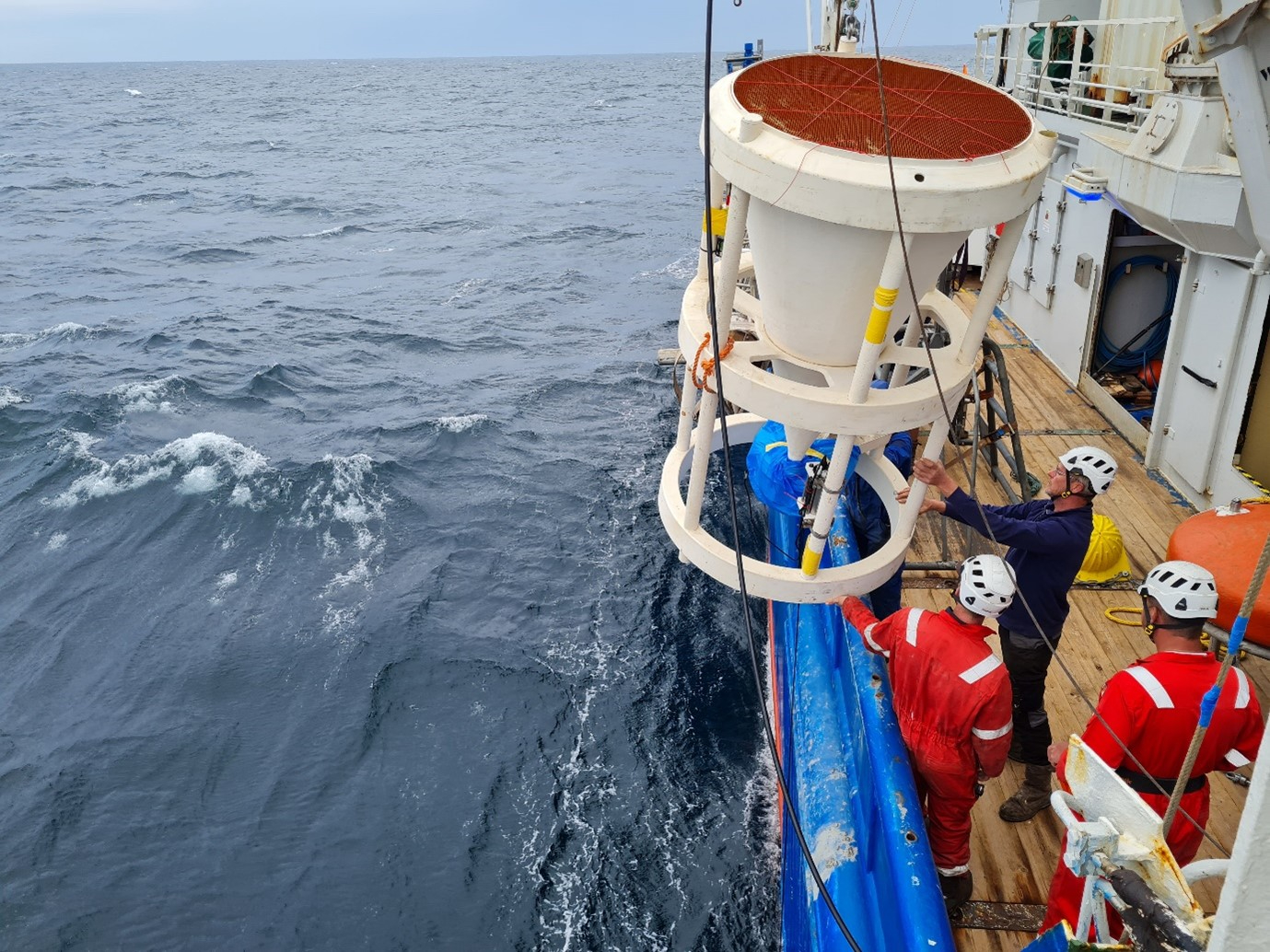
On the 25th of April we started our journey from Texel with the RV Pelagia to the Norwegian Trench as part of the NoSE project. The Norwegian Trench is the deepest part of the North Sea and the main outflow route of water from the North Sea into the Atlantic Ocean. During the expedition we will follow the outflow water and study processes that influence the carbon and nutrient cycles to determine what is exported to the Atlantic Ocean and what is deposited in the Trench. Last year we have collected data and samples from the water column and the seafloor along east-west transects crossing the Norwegian Trench. This year we will revisit some sites, but also sample a bit closer to the Norwegian coast. We will also retrieve two moorings and one lander that have been collecting data and samples for a year.
6 May 2024
By Cecile Hilgen (PhD UU), Femke van Zanten (master-student UU)
Greetings from the sediments of the sea floor in the Norwegian Trench!
Marine sediments function as natural archives storing physical, biological, and chemical signals of past climate. Our goal is to analyse these archives and to develop a spatial and temporal understanding of the past role of the carbon and nutrient cycles of the North Sea on the Atlantic Ocean. We use a piston corer to retrieve long sediment records and a multi-corer to capture the top layer of sediment.

The resolution at which we can measure past climate changes depends on the sediment accumulation rate. By slicing the sediment in 0.5 cm with the hydraulic slicer, we aim to encompass the period of greatest anthropogenic impact (i.e., the past ~150 years), which will allow us to separate anthropogenic from natural variability in carbon and nutrient cycling. This will provide important context for understanding ongoing and future anthropogenic impacts on the North Sea. We will retrieve microfossils (which we can only see through the microscope!) from these sediment slices, such as dinoflagellate cysts, to determine whether we as humans have raised the primary productivity and therefore carbon burial of the North Sea (eutrophication) by adding nutrients (i.e., by using fertilizers) and CO2 (i.e., because of fossil fuels, industries) into the system. Aside from our scientific activities, there are several other routine tasks that need to be done daily. These include cleaning cores/hands/deck, labelling cores/bags/vials, and documenting descriptions of cores we store on board.
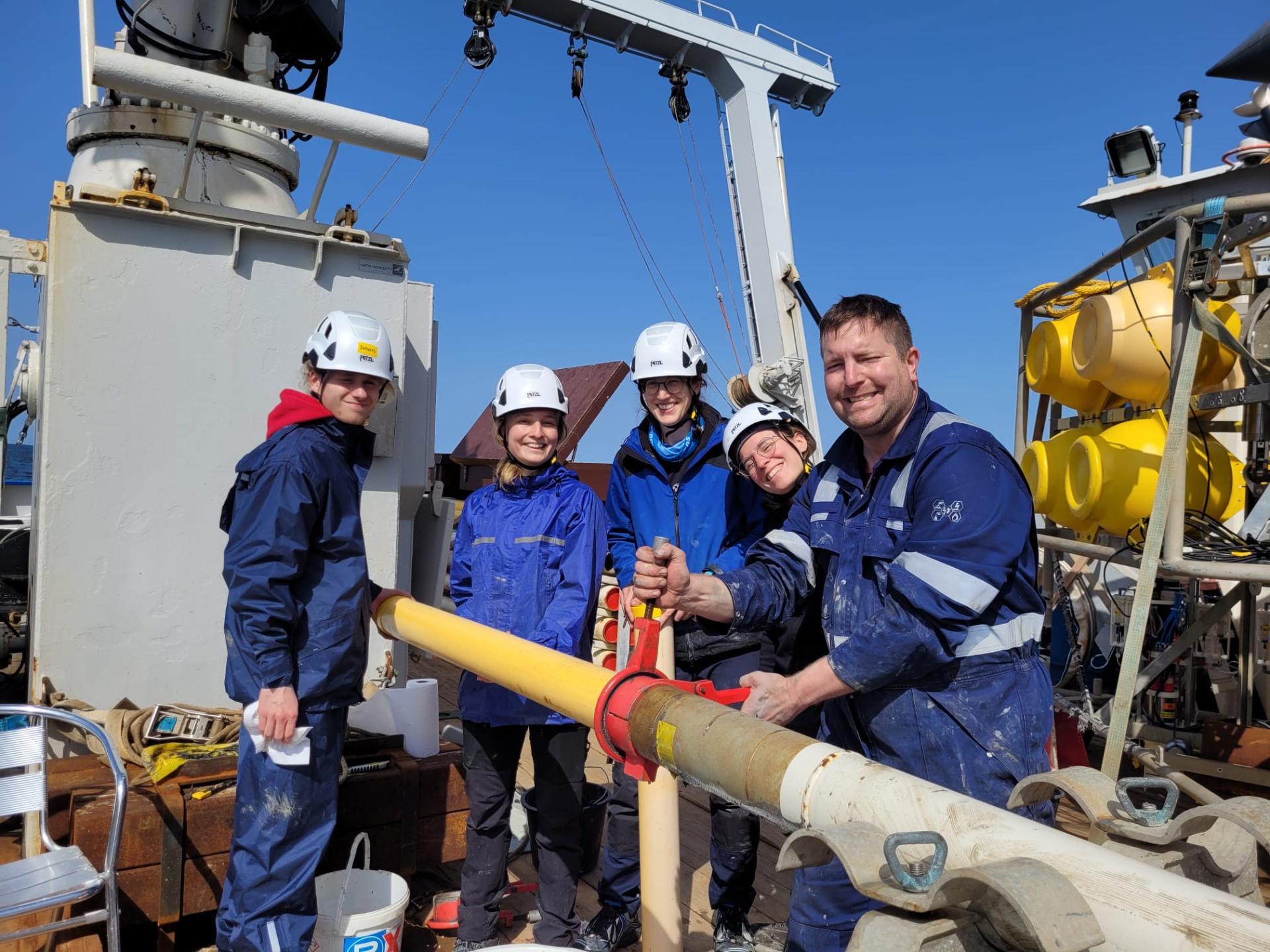
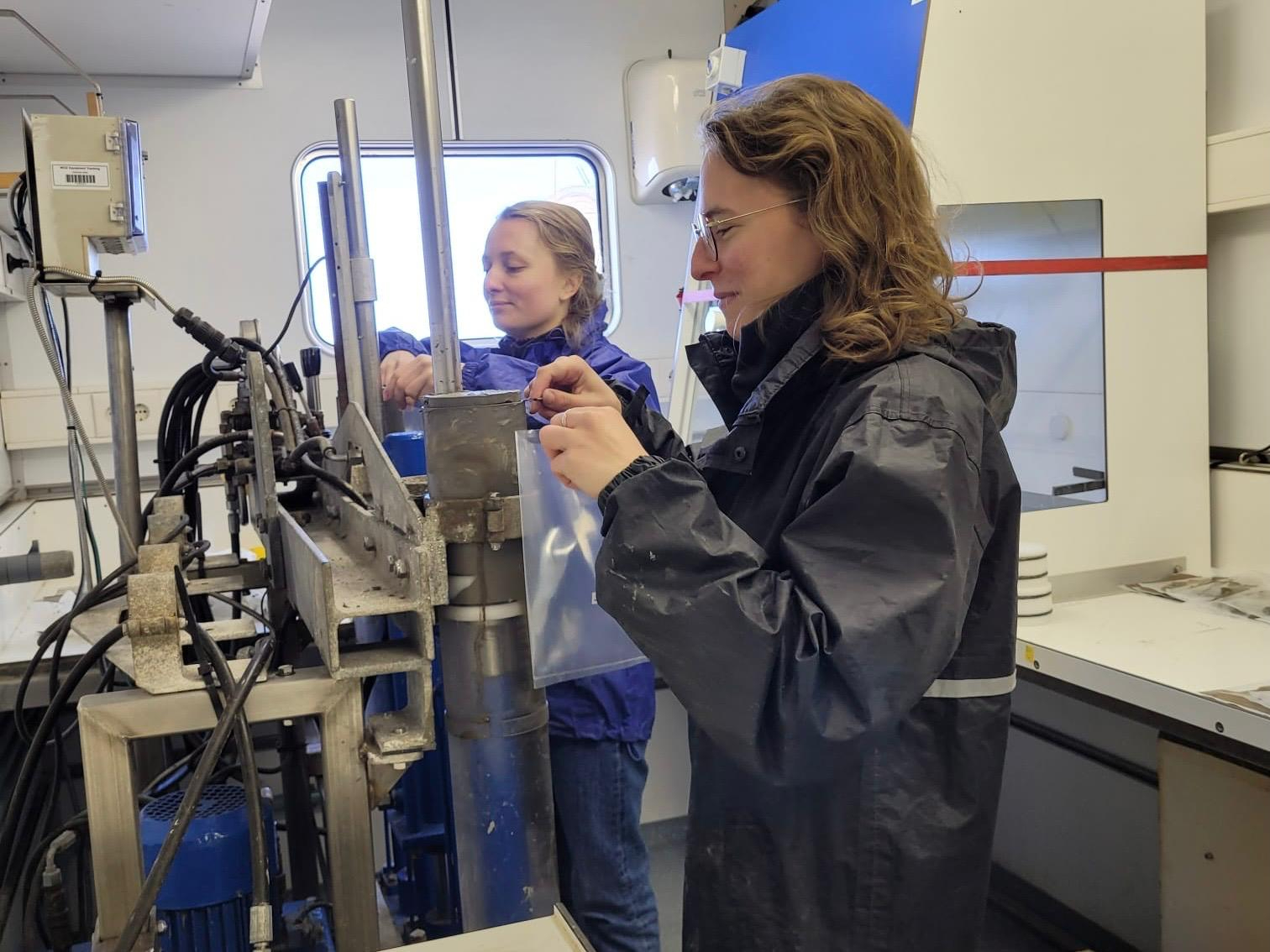
8 May 2024
In situ experiments with benthic landers
During the NoSE expedition, we study the carbon and nutrient cycles in the water column and the seafloor, where some of us have special interest in the processes at the interface between the two. For this, we use benthic landers that we deploy at the seafloor equipped with many different instruments to measure the near-bed environmental conditions like current speed, temperature and oxygen concentrations. As a special treat, the system includes three NIOZ-designed benthic chambers to measure rates of carbon and nutrient cycling right there at the seafloor.
After the lander lands on the seafloor small boxes are pushed into the sediment, enclosing a small part of the seafloor and the overlying seawater. During the following 10 hours we measure the rate at which oxygen is decreasing and take water samples in- and outside the chamber to analyse changes in nutrient concentrations such as phosphate, ammonium, and nitrate. These data will tell us how much carbon is consumed at the seafloor per square meter and if the sediments are a source or sink for nutrients. Finally, the sediment is sieved to quantify the species and abundance of deep-sea fauna that were present in the chambers to determine their role in the carbon and nutrient cycles.
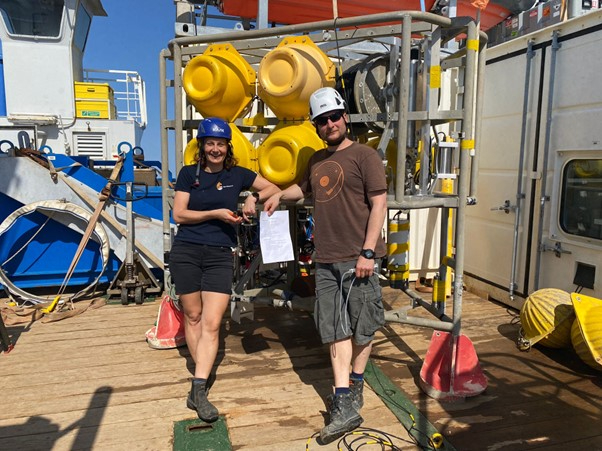
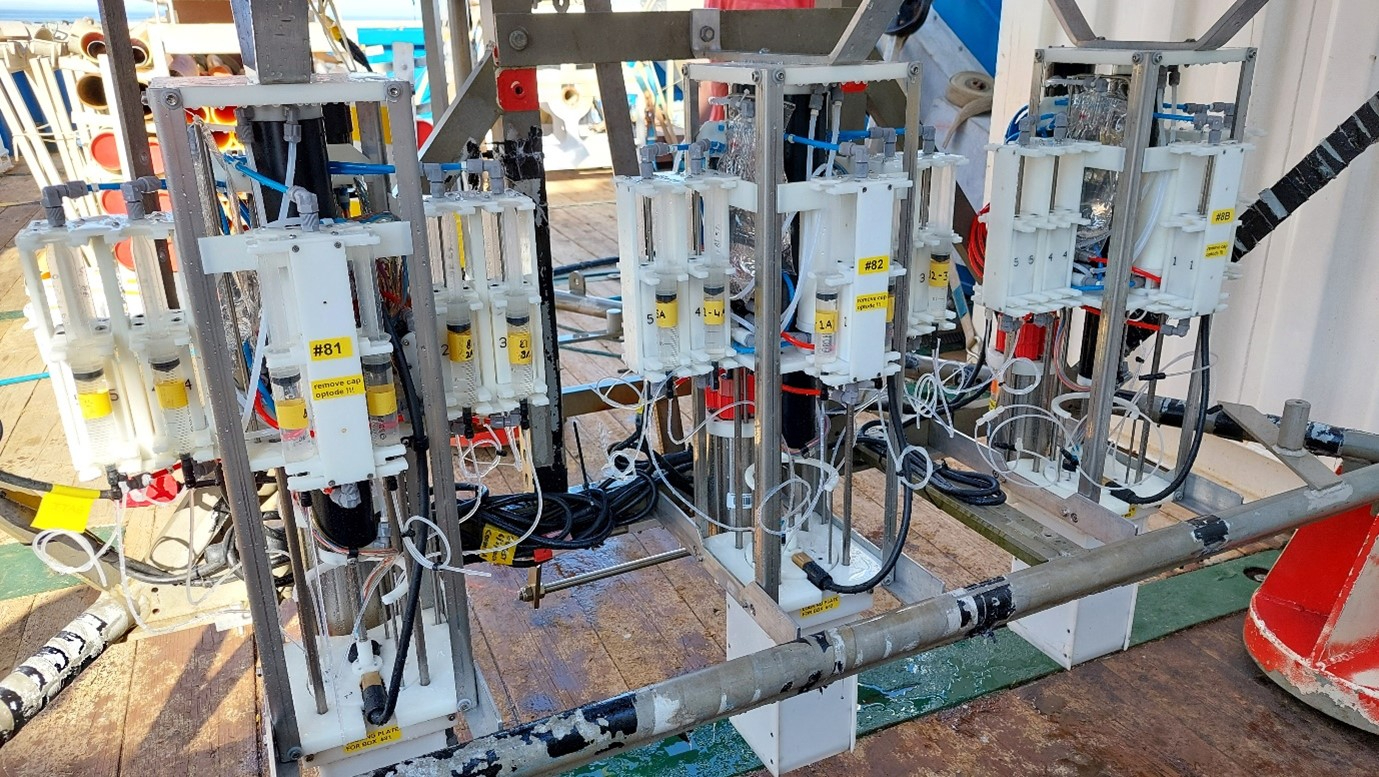
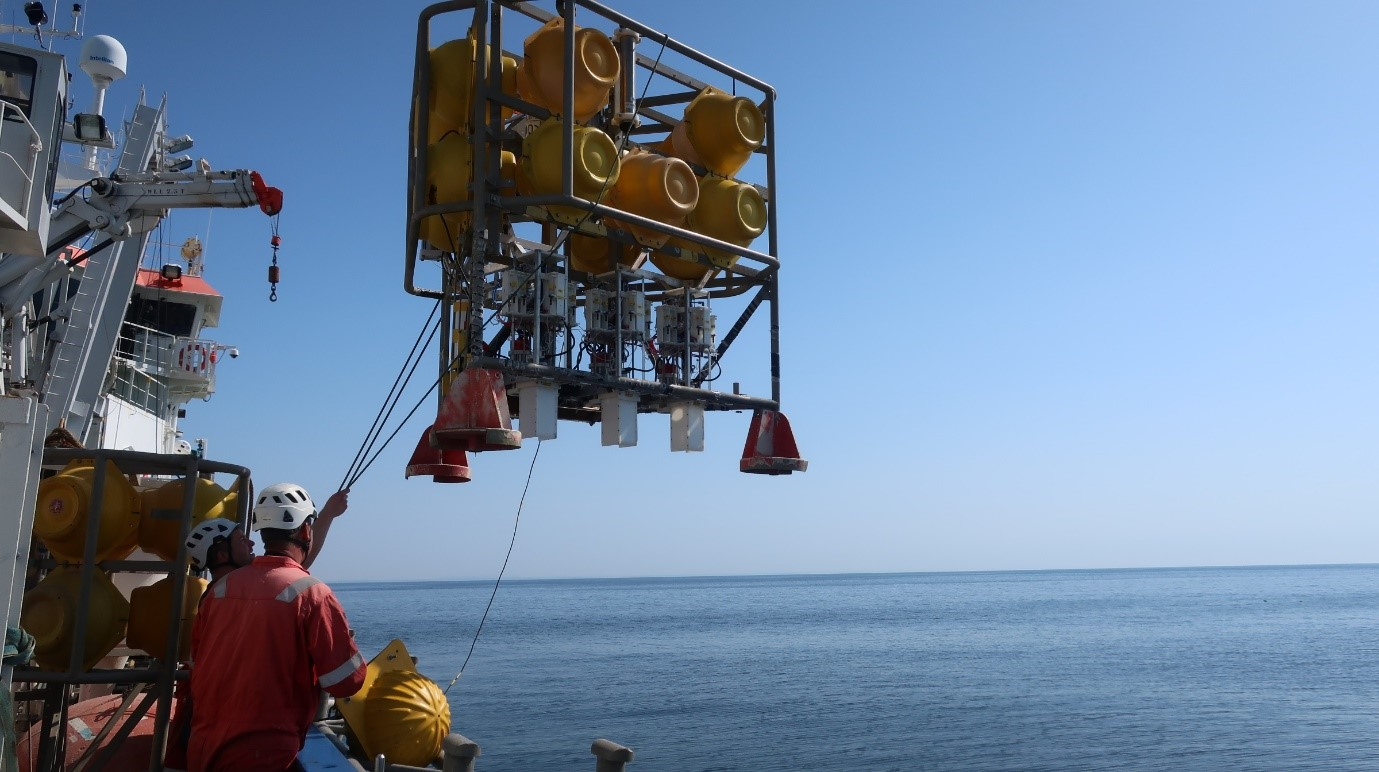
11 May 2024
During NoSE expedition 2024 we collect fresh sediment samples to perform different on-board measurements and experiments. The gathered data will help us to understand the role of sediments in benthic nutrient cycling. Nutrients coming from the water above the seafloor are exchanged with the sediment via the so-called sediment-water interface. With microsensors we can determine immediately how deep oxygen penetrates into the sediment and reveal the impact of biogeochemical processes on dissolved species (e.g. O2, redox, pH) in the top few centimeters of the sediment. The general idea using the microsensor is quite simple in principle: one takes the desired microsensors, and gradually lowers them down and into the sediment, with increments of several tens of micrometers. Luckily this process has been automated in our setup, making use of the multimeter, motor controller, and micromanipulator from Unisense A/B. With these, initial and final depth, as well as the step size, can be set. Measurements then go automatically.
The main challenging aspect for us on this expedition has been to regulate the temperature of the sediment cores we are analysing. As sediment is sampled from the ocean, they are quite disturbed, so it is important to keep them at temperatures similar to those found at the site where they came from. To address this problem, we have been putting our small subcores in cold water baths, periodically supplemented with ice, while measuring. That way, the microbes should be prevented from being too active, and giving overestimation of microbial metabolism at the sediment-water interface.
The deeper we go into the sediment, the less oxygen is available for microbes and at a certain point the sediment is completely oxygen free (anoxic). However, some microorganisms can thrive under these conditions, and use other nutrients like sulfate or nitrate instead of oxygen for their metabolism. With the 35S-sulfate experiment we get insights in how fast specific nutrients are converted into metabolic end products. For this experiment we collect samples from certain sediment depths, add a radioactive tracer and leave the samples anoxic and at a temperature similar to the conditions found at the seafloor. Then, we wait for a couple of days, in which sulfate-reducing bacteria can do their work. The radioactivity of the metabolic end product can be measured later on in the laboratory on Texel and based on that sulfate reduction rates can be calculated. Together with porewater data that show the variability of nutrients within the sediment we will get a complete picture of biogeochemical processes and rates in the sediments of the Norwegian Trench.
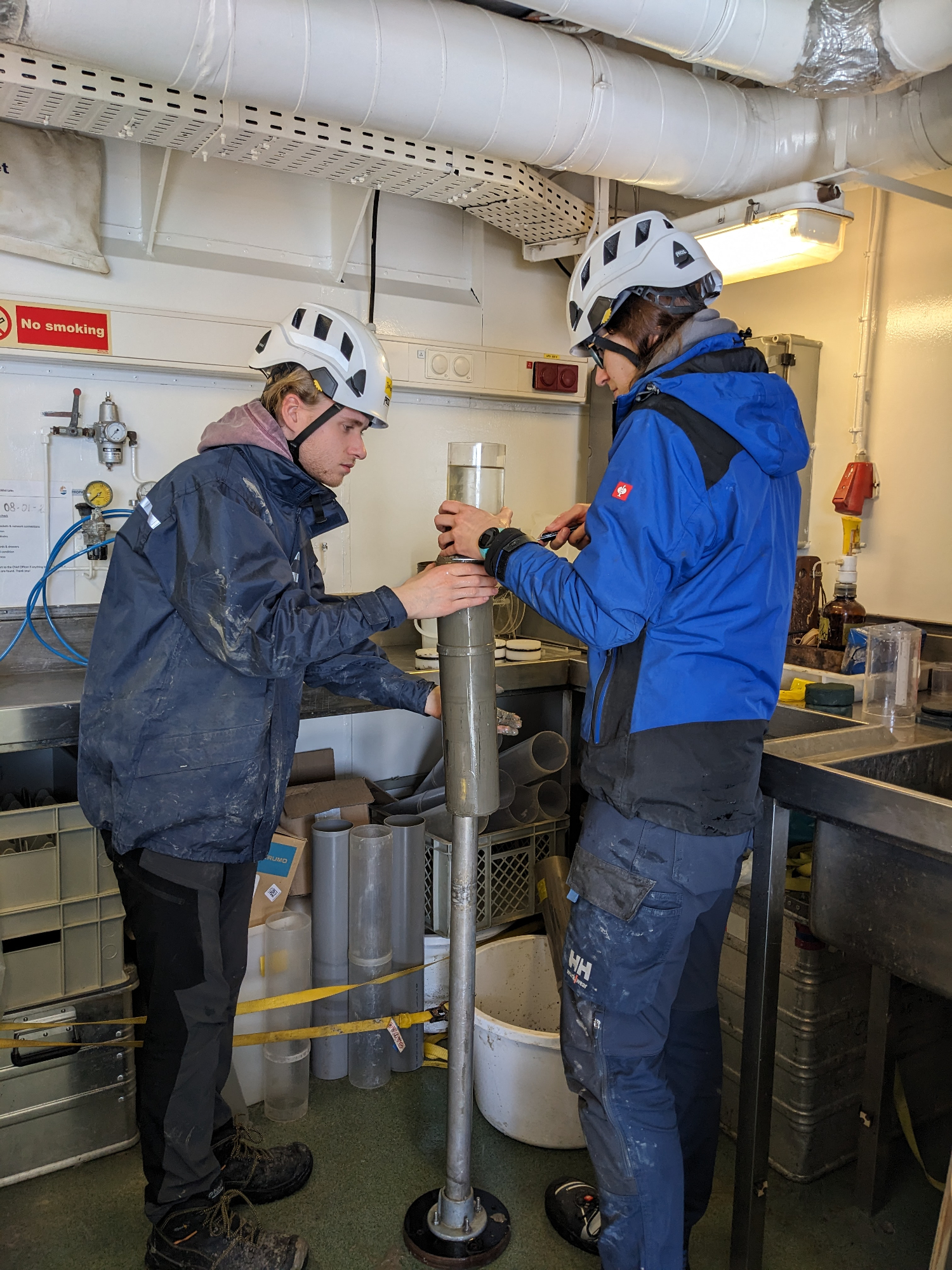
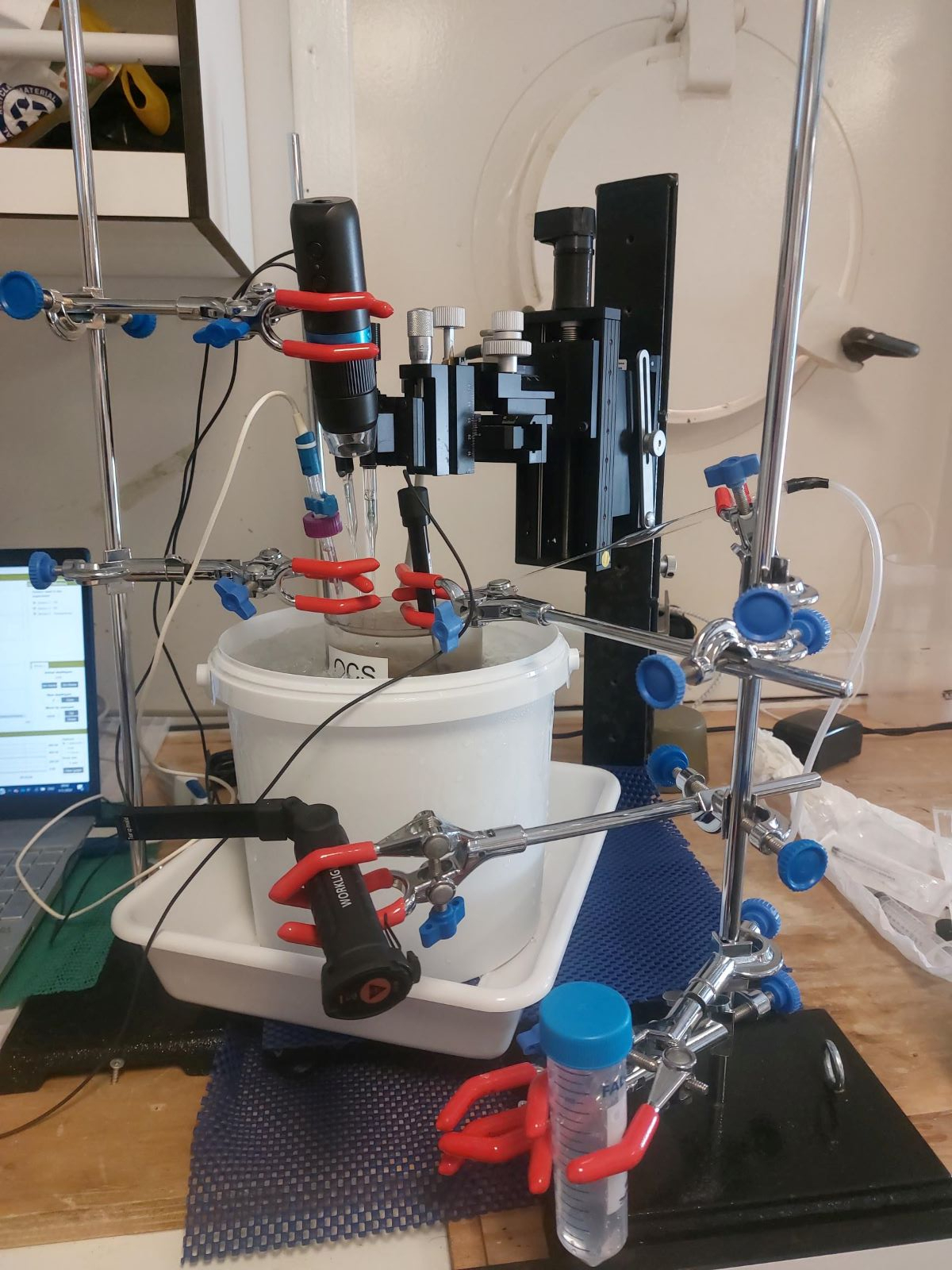
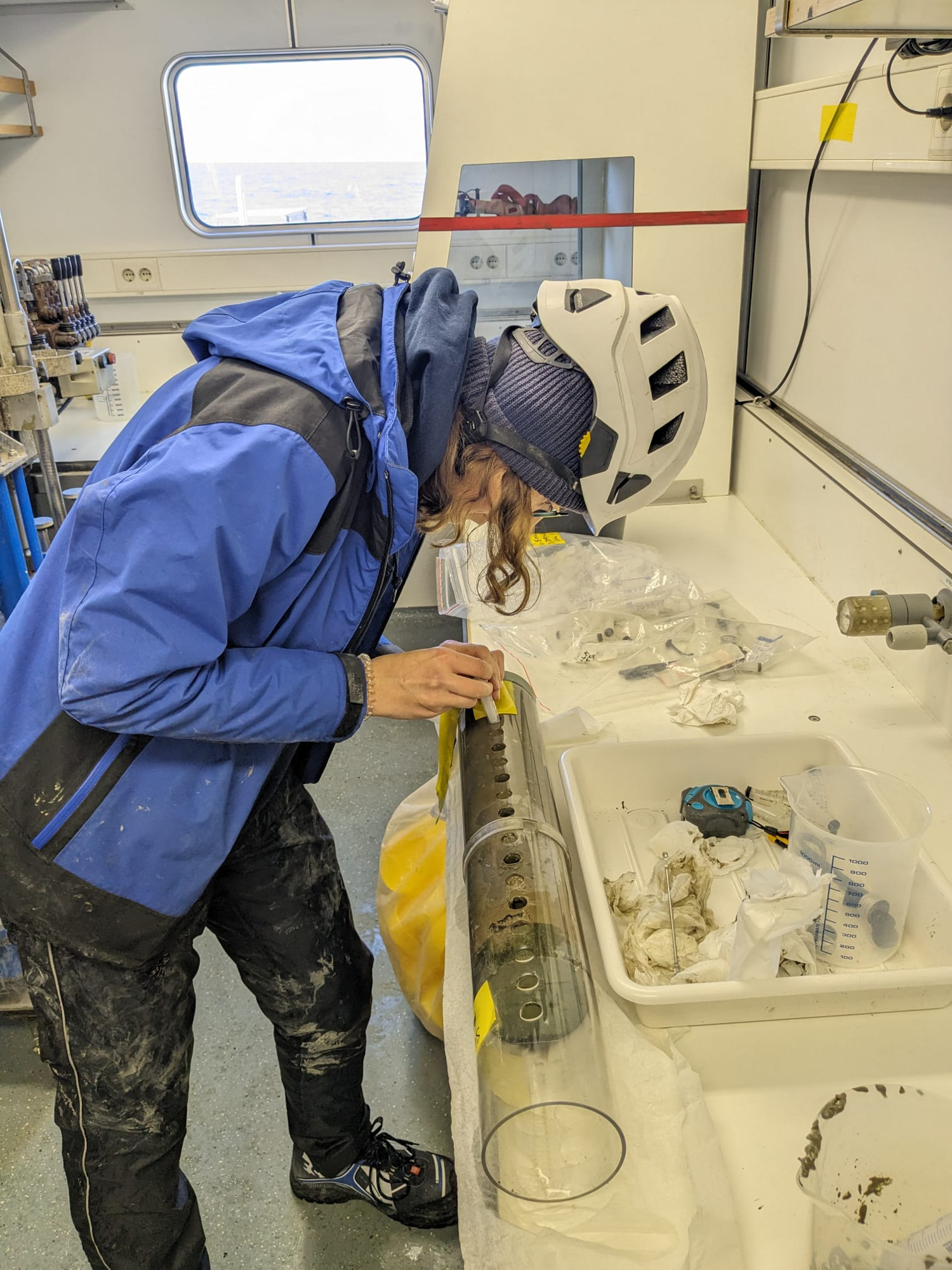

12 May 2024
By Matthew Humphreys
For the past couple of weeks, our journey through the Norwegian Trench on RV Pelagia has been shadowed by a pair of underwater robots called ocean gliders. The gliders, which resemble yellow torpedoes with wings, dive up and down between the sea surface and sea floor, pausing every few hours to send data and receive new instructions by satellite.
Each glider is equipped with sensors that record the physical, chemical and biological properties of the water that it passes through. So the gliders act like extra ‘eyes and ears’ for us, keeping track of what’s going on in the ocean while we on the ship are busy with other tasks. This is particularly useful in our study area because the ocean currents and swirling eddies are constantly on the move, making it difficult to get an overall picture from ship-based measurements alone.
One glider has been travelling along the length of the Norwegian Trench from south to north, while the other has been crossing it from east to west. Together, they have already travelled over 500 kilometres since being deployed and collected masses of valuable data.
After the expedition, we’ll use the glider data to see how well the sampling stations we’ve been visiting with the ship represent the surrounding area. This will help us better understand how carbon and nutrients are exchanged between the North Sea and Atlantic Ocean, which is critical to the North Sea’s continued absorption of CO2 from the atmosphere.


15 may 2024
An important research topic during the NoSE research expeditions is the fate of nutrients (carbon, nitrogen, phosphorus) in the seafloor of the deep North Sea. These nutrients were originally taken up by plankton in surface waters, and transported down when the plankton dies and sinks. Microbes in the seafloor break down this biomass and release the nutrients, that are partly recycled back into the water column and partly buried. The buried nutrients are either very slowly released back to the water, or not at all because they form minerals in the sediment. In this way, the sediment acts as a ‘sink’ for nutrients. The big question for us: how big is this sink and what are the processes behind it?
Determining the composition of the solid sediment tells us a lot about the size of the nutrient sink, from the present to the (distant) past. So, we take long cores of up to 9 m that allow us to reconstruct nutrient burial in the seafloor over the last few thousand years. But if we want to understand the processes behind nutrient recycling or retention, we are also interested in depth profiles of dissolved nutrients; these reflect ongoing biogeochemical cycling. To unravel all this, at some locations we take long cores with tubes that allow us to take samples directly that are then used to analyze important dissolved species: carbon (including methane, CH4, which can form deep in sediments), nitrogen, phosphorus, anything we need, really.
The first results from a long core we processed in this way are very promising: dissolved phosphate and nitrogen profiles suggest that deep in the sediment these essential elements are undergoing unexpected transformations that impact their long-term fate. These findings will provide new information about how the seafloor removes nutrients from the North Sea. Further analyses back home will complete what appears to be an exciting story about coupled cycles of nutrients deep in the sediment.

15 May 2024
We are ready to investigate temporal variability in the Norwegian Trench!
By Anna Enge
How much does a system like the Norwegian Trench change over a week, a month or even a year and what are the drivers of these changes? These are important questions to answer to understand the systems variability, or specifically in the case of the NoSE project, the variability of carbon and nutrient exchange of the North Sea and the Atlantic Ocean through the Norwegian Trench. We are able now, after one year time, to start answering these questions.
During the first NoSE expedition in 2023 we deployed two Moorings from the bottom to 100 m above the bottom, one in the east of the Norwegian Trench to capture North Sea outflow and one in west to capture Atlantic water inflow. We attached multiple sensors and instruments to measure water column properties like current velocities (with ADCPs, ADVs and Aquadops), temperature and salinity (with CT sensors), particle concentrations (with turbidity sensors and sediment traps) and pH (with pH sensors). A few days ago we successfully recovered both Moorings with all instruments.
We are now downloading the data and fill the back-up drives to secure the data. First impressions indicate that the instruments worked properly. Although it is too early to draw conclusions, we can identify tidal variations in the flow velocity as well as extremer events with high flow velocities and resuspension of sediment from the seabed. We are super excited to analyse the data further to unravel the mechanisms that cause flow variability in the Norwegian Trench. The large variety of instruments will provide multiple lines of evidence for understanding how the Norwegian Trench system changes over time. Temperature, salinity and pH data can help us to identify water masses and link them to the current velocity data, but also discover seasonal changes of water mass occurrence, origin and properties. The sediment trap will provide us with information about temporal variability in particle and carbon fluxes, which will show how much material from the productive surface layer is exported to greater depths. In a few days we will deploy both Moorings again for one year, so our data set grows and allows us to analyse variability over 2 years’ time.



